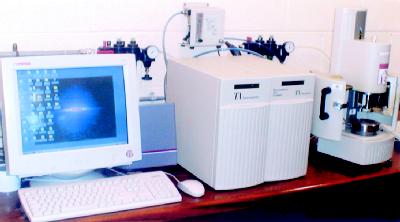| 2005 |

|
YEAR BOOK |
Athlone Institute of Technology
|
New generation "smart" materials at Athlone IT
|

The term hydrogel is used to describe materials that are three-dimensional, hydrophilic, polymeric networks capable of imbibing large amounts of water or biological fluids. They are best considered as polymeric materials, which are able to swell in water and retain a significant fraction of water within their structure, but do not completely dissolve. Hydrogels are becoming increasingly important materials for pharmaceutical applications. They are used in a variety of applications including diagnostic, therapeutic, and implantable devices for example, controlled release drug delivery systems which have been studied extensively, contact lenses and tissue engineering. Hydrogels have been widely used in such applications because of their biocompatibility with the human body and also because they resemble natural living tissue more than any other class of synthetic biomaterials. This is due to their high water content and soft consistency which makes them similar in characteristics to natural tissue.

Changing the degree of crosslinking has been utilised to achieve the desired mechanical properties of the hydrogels. Increasing the degree of crosslinking of the system will result in a stronger gel. However, a higher degree of crosslinking creates a more brittle structure. Hence, there is an optimum degree of crosslinking at which a relatively strong and yet elastic hydrogel, exists. Copolymerisation has also been utilized to achieve the desired mechanical properties of hydrogels. Incorporating a co-monomer that will contribute to hydrogen bonding can increase the strength of the hydrogel.

|
* Drug Delivery The focus of this research is to develop drug delivery systems based on stimuli sensitive polymers. The stimuli in which we are interested, include change in pH, change in temperature and change in glucose concentration. The latter has significant consequences in the treatment of diabetes. * Coatings The aim of this research is to develop methods for producing and applying lubricious hydrophilic coatings. These are coatings which, when applied to medical devices, such as catheters, become slippery when wet so that they can be inserted into the human body with ease. * Coatings for drug delivery This research combines the coatings research and the drug delivery research. The aim is to develop a coating into which a drug can be incorporated. The drug can then be released slowly over a specified period of time. * Biomaterials for tissue engineering This research is aimed at developing new biodegradable polymeric materials, or modifying existing polymeric materials, suitable for reconstructive surgery applications. For these applications it is essential that a high level of spontaneous tissue growth through the pore structure of the polymer be achieved, as part of the inflammatory response. |
Contact: Dr. Clement L. Higginbotham; E-mail: [email protected] ;
Michael Nugent; E-mail: [email protected] ;
Centre for Biopolymer and Biomolecular Research,
Athlone Institute of Technology, Dublin Road, Athlone, Co. Westmeath;
Tel: 353 (0) 90 6424400